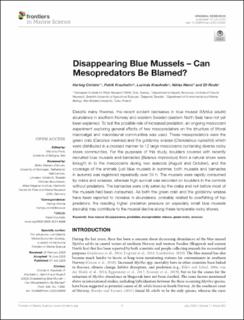| dc.contributor.author | Christie, Hartvig | |
| dc.contributor.author | Kraufvelin, Patrik | |
| dc.contributor.author | Kraufvelin, Lucinda | |
| dc.contributor.author | Niemi, Niklas | |
| dc.contributor.author | Rinde, Eli | |
| dc.date.accessioned | 2021-05-31T10:26:57Z | |
| dc.date.available | 2021-05-31T10:26:57Z | |
| dc.date.created | 2021-02-17T08:05:59Z | |
| dc.date.issued | 2020 | |
| dc.identifier.citation | Frontiers in Marine Science. 2020, 7, 550. | en_US |
| dc.identifier.issn | 2296-7745 | |
| dc.identifier.uri | https://hdl.handle.net/11250/2757027 | |
| dc.description.abstract | Despite many theories, the recent evident decreases in blue mussel (Mytilus edulis) abundance in southern Norway and western Sweden (eastern North Sea) have not yet been explained. To test the possible role of increased predation, an ongoing mesocosm experiment exploring general effects of two mesopredators on the structure of littoral macroalgal and macrofaunal communities was used. These mesopredators were the green crab (Carcinus maenas) and the goldsinny wrasse (Ctenolabrus rupestris) which were distributed in a crossed manner to 12 large mesocosms containing diverse rocky shore communities. For the purposes of this study, boulders covered with recently recruited blue mussels and barnacles (Balanus improvisus) from a natural shore were brought in to the mesocosms during two seasons (August and October), and the coverage of the animals (just blue mussels in summer, both mussels and barnacles in autumn) was registered repeatedly over 24 h. The mussels were rapidly consumed by crabs and wrasses, whereas high survival was recorded on boulders in the controls without predators. The barnacles were only eaten by the crabs and not before most of the mussels had been consumed. As both the green crab and the goldsinny wrasse have been reported to increase in abundance, probably related to overfishing of top predators, the resulting higher predation pressure on especially small blue mussels (recruits) may contribute to the mussel decline along these temperate rocky shores. | en_US |
| dc.language.iso | eng | en_US |
| dc.publisher | Frontiers | en_US |
| dc.rights | Navngivelse 4.0 Internasjonal | * |
| dc.rights.uri | http://creativecommons.org/licenses/by/4.0/deed.no | * |
| dc.title | Disappearing Blue Mussels – Can Mesopredators Be Blamed? | en_US |
| dc.type | Peer reviewed | en_US |
| dc.type | Journal article | en_US |
| dc.description.version | publishedVersion | en_US |
| dc.rights.holder | Copyright © 2020 Christie, Kraufvelin, Kraufvelin, Niemi and Rinde | en_US |
| dc.source.pagenumber | 8 | en_US |
| dc.source.volume | 7 | en_US |
| dc.source.journal | Frontiers in Marine Science | en_US |
| dc.identifier.doi | 10.3389/fmars.2020.00550 | |
| dc.identifier.cristin | 1890674 | |
| dc.source.articlenumber | 550 | en_US |
| cristin.ispublished | true | |
| cristin.fulltext | original | |
| cristin.qualitycode | 1 | |

